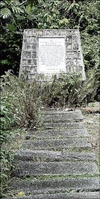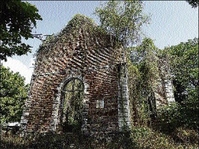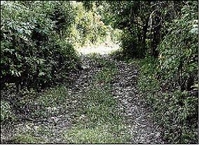Paul Bogle's home a 'site' to see - Stony Gut destroyed by the British after Morant Bay Rebellion
Published: Sunday | December 20, 2009

A section of the property in Stony Gut, St Thomas, where Paul Bogle's house was.
IN SPRING Garden, St Thomas, The Sunday Gleaner sees a sign pointing left, indicating Stony Gut. The descent is steep but the road is good and it does not take long to reach where Paul Bogle's home and the village of Stony Gut are.
Actually, were. For while there is a monument, accessible by a concrete walkway, there are no houses. Stony Gut, including Paul Bogle's home and chapel, simply do not exist anymore. There is a roughly semi-circular clearing to indicate the outlines of Stony Gut, but it is simply a site.
"They came in and destroyed the village," Donovan Edwards, caretaker and guide, said. "After the oppression, people move up the side. Even the road is not the original road." The road leading to Stony Gut was built specifically to access the site, while the original road made a more circuitous descent into the village.
old roads
Before going on to the pathway, Edwards shows The Sunday Gleaner the impressions of two old roads leading away from the cul-de-sac in which the new road to Stony Gut ends. The one to the left is called Bruck Heart Road. "My theory is that after Paul Bogle and him man them go Spanish Town and get turn down, that's where they came back," he said.
Only a set of stones in a circular pattern, to the left of the walkway, remains of Bogle's chapel. They are single stones, with no elevation to show that they were once part of a wall. When The Sunday Gleaner visited, a crew of workmen from Port Royal was doing maintenance on the grounds.
An apple tree sprinkles its rich mauve blossoms on a small section of the walkway, which is otherwise a gently upward-sloping trek to the concrete monument. On it is written: "Here was located the chapel and house of National Hero The Right Excellent Paul Bogle. It was from this spot, on October 11, 1865, that Deacon Bogle led his people to Morant Bay to protest on behalf of the humble Jamaicans. This march and subsequent events became known as the Morant Bay Rebellion. It was brutally put down by Governor Eyre. Deacon Bogle was taken near Stony Gut on October 23, 1865, tried and executed at Morant Bay on October 24, 1865."
The inscription ends with the location of other monuments to "this great Jamaican".
finest public moment
Edwards estimates the Stony Gut site is two and a half acres and says the walkway was done in 1977. That year, he says, Stony Gut had its finest public moment, with a visit by heads of state.
"We march from here that day to the statue in Morant Bay. It was a great and exciting day," he said, remembering that there was kumina and lots of drumming. "I can't forget that day," he said.
Edwards has worked at the site since 1991 and says these days "I mostly get visits from university students, church groups and visitors to the island".
It is officially open on Mondays to Fridays from 8 a.m. to 4 p.m., although as it is not enclosed, people do visit outside those days and times.

Old church were Paul Bogle was hanged. - photos by Ian Allen/Photographer

The statue of Paul Bogle in bronze.

The old Stony Gut road.








